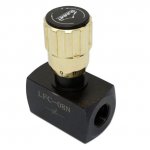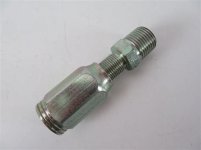When I bought TUG (DMC 1450) the package included a factory-supplied tandem axle, tilting trailer. But as is often the case there were issues, and working through those was a genuine pain in the neck. Trailers come with a VIN sticker or plate which has the manufacturer as well as the serial number, and usually other pertinent data such as the GVWR (Gross Vehicle Weight Rating) and the date of manufacture. But no such sticker or plate could be found. If you are (logically) wondering how that could be, the original purchaser was the .gov, and the rules that apply to us don’t seem to apply to them. Imagine that?
The trailer's damping or cushioning cylinder for the tilting action was missing, though you could see exactly where it mounted. Without any cushioning or damping it was essentially a teeter totter, totally depending on gravity. That’s truly a less-than optimal-setup, and loading or unloading the snowcat can provide an "unwelcome level of excitement” (How’s that for phraseology?).
I knew a company called Maxey, out of Fort Collins, CO builds tilting snowcat trailers, and I reached out to them first. The parts lady was initially very helpful, but when it turned out the trailer wasn’t a Maxey, help dried up fast. I then contacted Peterson Equipment in Logan, UT as they were a Thiokol/DMC/LMC dealer for many years. That parts lady was also helpful, and she emailed me a copy of the original order sheet but that only said “4-ton Trailer, pintle hitch” and the serial number. In our conversation she told me a trailer company in Nevada had supplied trailers to Thiokol/DMC/LMC per Thiokol’s design. She thought the name of that company was Southwest Trailer but also said they had gone out of business many years ago. She suggested I reach out to Bailey Hydraulics for help. I called them and yet another nice lady tried to help. She said “It would be a custom cylinder, they start at $1,000, and there is a 31 week lead time”. That wasn’t going to work….
Scott and I took multiple measurements from the trailer and laid out the trailer’s cylinder mounting dimensions along with the hinge point on his CAD system. That allowed us to determine the optimal hydraulic cylinder configuration and see exactly how the geometry worked. Then lots of time spent doing Internet research. Many cushioning cylinder setups use a standard hydraulic cylinder with an external hose running between the two hydraulic ports with a valve to regulate the flow of fluid. But the original cylinders have no hose or valve and I preferred that setup. Fluid has to flow back and forth through the piston as the trailer tilts up and/or down. More research, more dead ends, and I finally found a trailer company that offered a tilt trailer cushion cylinder - though the cylinder dimensions wouldn’t work for our application. Still though, this was a step in the right direction, and they might have some information... so I called 'em. The parts guy was very nice and when I explained our situation, he told me the name of the company that supplied their cylinders. Progress at last!
I then reached out to them, and they too were very helpful. The gentleman looked over drawings of their cushion cylinders, and I was stunned when he said the size of the orifice was .035. That is downright tiny! In fact, in my drill index the smallest drill bit I have is.038. I was very concerned about the difficulty of drilling such a hole with what is basically a very delicate drill bit. I ordered a new cylinder, and after confirming it fit properly on the trailer, we disassembled the cylinder to drill the piston. The piston itself is roughly an inch thick and Scott pointed out while the orifice had to be .038, we could drill most of the way through the piston with a larger drill bit with only a small portion of the piston being .038. And that's what we did. Honestly, my concerns were for naught as the drilling process (using Scott’s drill dress) was uneventful. The cylinder reassembly went smoothly and then we had to add hydraulic fluid. We used ATF, but the question is how much fluid to add? We extended the cylinder to the proper dimension with the trailer tilted up and filled the end of the cylinder without the piston rod, then added a small amount of fluid to the other side. Then we installed the cylinder and it came time for the moment of truth…would it work?
And…. it dampened the tilt considerably, but part of the tilting action went pretty fast while most was nice and slow. We concluded there was too much air and not enough fluid in the cylinder, so off it came to add some more fluid. I wish I could tell you we precisely calculated the amount of fluid, and added that exact amount. But the reality is we used the tried and true TLAR method: (That Looks About Right). And after adding more fluid and reinstalling the cylinder - the tilting action is smooth and controlled.
Here's a pic of the installed cylinder.

When all is said and done we probably have 12 hours of time and a couple hundred bucks in sorting out this issue. Will a customer pay more for having a damping cylinder on the trailer? Probably not, and they certainly wouldn’t pay market rates for our time. But knowing that we’re selling a trailer that’s considerably safer to load and unload provides enough compensation for us. Details matter, even if they’re not always appreciated….
The trailer's damping or cushioning cylinder for the tilting action was missing, though you could see exactly where it mounted. Without any cushioning or damping it was essentially a teeter totter, totally depending on gravity. That’s truly a less-than optimal-setup, and loading or unloading the snowcat can provide an "unwelcome level of excitement” (How’s that for phraseology?).
I knew a company called Maxey, out of Fort Collins, CO builds tilting snowcat trailers, and I reached out to them first. The parts lady was initially very helpful, but when it turned out the trailer wasn’t a Maxey, help dried up fast. I then contacted Peterson Equipment in Logan, UT as they were a Thiokol/DMC/LMC dealer for many years. That parts lady was also helpful, and she emailed me a copy of the original order sheet but that only said “4-ton Trailer, pintle hitch” and the serial number. In our conversation she told me a trailer company in Nevada had supplied trailers to Thiokol/DMC/LMC per Thiokol’s design. She thought the name of that company was Southwest Trailer but also said they had gone out of business many years ago. She suggested I reach out to Bailey Hydraulics for help. I called them and yet another nice lady tried to help. She said “It would be a custom cylinder, they start at $1,000, and there is a 31 week lead time”. That wasn’t going to work….
Scott and I took multiple measurements from the trailer and laid out the trailer’s cylinder mounting dimensions along with the hinge point on his CAD system. That allowed us to determine the optimal hydraulic cylinder configuration and see exactly how the geometry worked. Then lots of time spent doing Internet research. Many cushioning cylinder setups use a standard hydraulic cylinder with an external hose running between the two hydraulic ports with a valve to regulate the flow of fluid. But the original cylinders have no hose or valve and I preferred that setup. Fluid has to flow back and forth through the piston as the trailer tilts up and/or down. More research, more dead ends, and I finally found a trailer company that offered a tilt trailer cushion cylinder - though the cylinder dimensions wouldn’t work for our application. Still though, this was a step in the right direction, and they might have some information... so I called 'em. The parts guy was very nice and when I explained our situation, he told me the name of the company that supplied their cylinders. Progress at last!
I then reached out to them, and they too were very helpful. The gentleman looked over drawings of their cushion cylinders, and I was stunned when he said the size of the orifice was .035. That is downright tiny! In fact, in my drill index the smallest drill bit I have is.038. I was very concerned about the difficulty of drilling such a hole with what is basically a very delicate drill bit. I ordered a new cylinder, and after confirming it fit properly on the trailer, we disassembled the cylinder to drill the piston. The piston itself is roughly an inch thick and Scott pointed out while the orifice had to be .038, we could drill most of the way through the piston with a larger drill bit with only a small portion of the piston being .038. And that's what we did. Honestly, my concerns were for naught as the drilling process (using Scott’s drill dress) was uneventful. The cylinder reassembly went smoothly and then we had to add hydraulic fluid. We used ATF, but the question is how much fluid to add? We extended the cylinder to the proper dimension with the trailer tilted up and filled the end of the cylinder without the piston rod, then added a small amount of fluid to the other side. Then we installed the cylinder and it came time for the moment of truth…would it work?
And…. it dampened the tilt considerably, but part of the tilting action went pretty fast while most was nice and slow. We concluded there was too much air and not enough fluid in the cylinder, so off it came to add some more fluid. I wish I could tell you we precisely calculated the amount of fluid, and added that exact amount. But the reality is we used the tried and true TLAR method: (That Looks About Right). And after adding more fluid and reinstalling the cylinder - the tilting action is smooth and controlled.
Here's a pic of the installed cylinder.
When all is said and done we probably have 12 hours of time and a couple hundred bucks in sorting out this issue. Will a customer pay more for having a damping cylinder on the trailer? Probably not, and they certainly wouldn’t pay market rates for our time. But knowing that we’re selling a trailer that’s considerably safer to load and unload provides enough compensation for us. Details matter, even if they’re not always appreciated….


